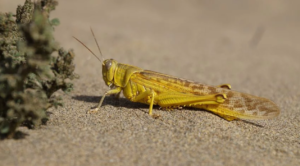For the latest information on the Desert Locust situation, please see the Food and Agriculture Organization of the United Nations (FAO) Locust Watch website.
The Desert Locust is known throughout history for its capacity to reach plague-like swarms, descending from the sky to ravage crops and trouble farmers. Scientifically named Schistocerca gregaria (Forskål 1775), this species undergoes an almost “Dr. Jekyll and Mr. Hyde” type of transformation called locust phase polyphenism. The Desert Locust can change from a solitary insect, behaving more like a typical grasshopper, into a “gregarious” form that prefers high-density communities and lots of traveling. These gregarious adults make up clouds of locusts capable of migrating hundreds of kilometers in a single night.
These “clouds” are currently spreading throughout East Africa and up into India and Pakistan. While more research is still needed to understand the exact mechanisms for why the Desert Locust goes from long periods of low population “recessions” to periodically aggregate into massive swarms, we do know they are triggered by a combination of well-timed and abundant precipitation events and other environmental factors. The current outbreak is the worst situation the FAO has seen in decades and the worst in Kenya for the last 70 years.
The current invasion did not appear overnight. According to Dr. Michel Lecoq, past director of the locust and grasshopper ecology and control research unit of the French Agricultural Research Centre for International Development (CIRAD), “During the second half of April and again in October 2018, unusually strong tropical cyclones formed in the southern Arabian Sea. They caused heavy rains in Yemen, Oman, Djibouti, in northern Somalia, eastern Ethiopia, and in southern Rub al Khali in Saudi Arabia. The favorable conditions for Desert Locust breeding have been maintained for at least nine consecutive months (June 2018 to March 2019), allowing the development of three generations. These locusts remained undetected and therefore uncontrolled.”
Desert Locusts will consume almost anything and are capable of eating their body weight in food each day. This behavior translates into major damage to crops and native vegetation. The shock trickles down the economic chain, greatly impacting the food security and livelihoods of farmers and their families.
Dr. Lecoq said, “The results of the last major invasion in West Africa in 2004-2005 speak for themselves: 26 countries affected, 6.5 million hectares devastated, 13 million hectares treated with insecticides, crop losses estimated at 2.5 billion USD, and control costs estimated at more than 400 million USD, a figure most certainly underestimated.”
While preventative control has greatly reduced the severity of locust outbreaks in the past, Lecoq points to financial and organizational insecurity in many key zones, as largely responsible for the failure to control upsurges and invasions. As the current situation suggests, many management challenges remain to sustainably control such a prolific pest that ignores country boundaries, laws, and institutional agreements. “The answers are not only scientific and technical, but above all, financial, institutional, and ultimately political,” said Lecoq.
Read his full article to find out more about the past and future management of the Desert Locust.

